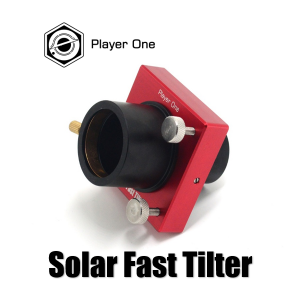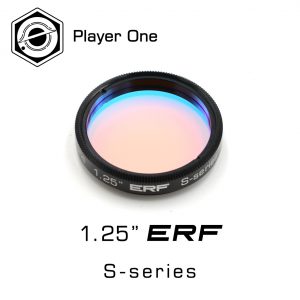Celestron’s newly designed CGX-L Computerized Equatorial Mount is the latest addition to the company’s fully computerized equatorial mount series and now offers a hefty 75-pound load capacity. Capable of carrying Celestron’s largest optical tubes, CGX-L is designed for backyard observatories and remote imagers looking for exceptional load capacity-to-weight ratio, compact design, and innovative features that fully support large telescopes, imaging kits, and the latest in wireless tech accessories.
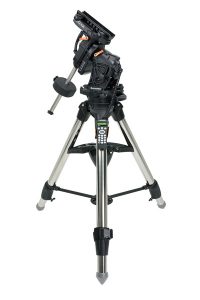 Key design goals included (1) larger 144-mm diameter worm wheels which provide smoother operation and can more accurately drive heavier loads, (2) a longer 270-mm dovetail saddle to support larger optical tubes, (3) remote-operation-friendly features such as home and limit optical sensors, (4) easier polar-alignment adjustments, and (5) better cable management overall. In addition, Celestron has made mechanical and ergonomic improvements throughout to make the mount sturdier, easier to use, and easier to transport.
Key design goals included (1) larger 144-mm diameter worm wheels which provide smoother operation and can more accurately drive heavier loads, (2) a longer 270-mm dovetail saddle to support larger optical tubes, (3) remote-operation-friendly features such as home and limit optical sensors, (4) easier polar-alignment adjustments, and (5) better cable management overall. In addition, Celestron has made mechanical and ergonomic improvements throughout to make the mount sturdier, easier to use, and easier to transport.
The new CGX-L offers an increased 75-pound load capacity offering exceptional load capacity to weight ratio. There are updated aux accessory ports and auto guider port on the Dec axis for better cable management. The mount offers massive 70-mm stainless steel tripod legs with a wider stance for improved stability under heavy loads.
The new accessory tray holds three 1.25-inch and two 2-inch eyepieces with an upright stand for your smartphone or tablet. The heavy-duty, 31.5-mm stainless-steel counterweight shaft provides the ability to support additional counterweights.
There is an optional add-on polar-axis finder scope specifically designed for Celestron’s CGX and CGX-L. The polar-axis finder supports Wi-Fi and wireless operation accessories, such as StarSense AutoAlign and SkyPortal WiFi Module (sold separately).
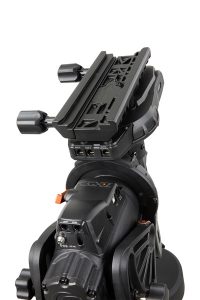 The mount offers a more compact, low-profile equatorial head providing improved stability and portability, and it is now sturdier and more rigid with quicker dampening time. The mount’s improved motors provide more torque, better slewing and tracking under heavy loads and the heavy-duty belt-drive system minimizes backlash while providing smooth motor operation at full capacity. Clear windows are built into the motor covers so pulleys and belts can be monitored. The spring-loaded brass worm wheel and stainless-steel worm gear reduce friction and provide optimum gear mesh.
The mount offers a more compact, low-profile equatorial head providing improved stability and portability, and it is now sturdier and more rigid with quicker dampening time. The mount’s improved motors provide more torque, better slewing and tracking under heavy loads and the heavy-duty belt-drive system minimizes backlash while providing smooth motor operation at full capacity. Clear windows are built into the motor covers so pulleys and belts can be monitored. The spring-loaded brass worm wheel and stainless-steel worm gear reduce friction and provide optimum gear mesh.
The improved internal cabling is designed for worry-free remote operation. Power input and lower accessory ports remain stationary while the mount slews to avoid snags. Internal hard stops for both axes prevent cable tension and tripod strike. The internal optical sensors on both axes provide simple and safe remote operation.
Home sensors allow the mount to always start in the index position regardless of orientation before a power reset. Limit sensors automatically shut off slewing or tracking before reaching the hard-stop fail safe.
The mount Includes Celestron’s new PWI telescope control software, co-developed by PlaneWave Instruments. The software features multi-point mount modeling for extremely precise pointing accuracy. The All-Star Polar Alignment allows quick and very precise polar alignment providing the ability to align on any bright named star without extra polar-alignment accessories, apps, or other assistance.
The adjustable EQ head position optimizes the center of gravity over the tripod and fully utilize the increased 3º-65º latitude range. The mount offers +20º of additional tracking past the meridian on either side.
 The redesigned tripod provides a widened stance for added stability. The minimum tripod height has also been lowered. The tripod legs can be collapsed with the accessory tray installed for faster setup and transport.
The redesigned tripod provides a widened stance for added stability. The minimum tripod height has also been lowered. The tripod legs can be collapsed with the accessory tray installed for faster setup and transport.
The mount features a dual-fit Vixen/CG-5 and Losmandy/CGE dovetail saddle. Integrated handles are placed for easy transport and portability. It also features new ergonomically designed dovetail clamping knobs.
The all-new, innovative polar-alignment adjustment system offers ergonomic adjustment knobs with reduced friction for smooth and easy positioning under full loads. The stationary latitude knob for the linkage system greatly reduces the amount of friction when polar aligning the mount.
The redesigned azimuth adjustment has low-friction Teflon bearings to make adjustments easy under full load, which means no more binding or rough adjustments. There is also an easy to read latitude scale.
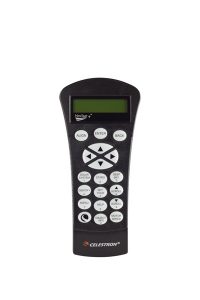 The mount’s electronics feature the NexStar+ hand control with USB 2.0 port used to connect directly to PC with PWI Software. There are two available autoguider ports for optimum cable management. The mount is PEC-sensor and PPEC ready, has a threaded 12-volt DC power input barrel connector and internal real-time clock, which keeps time and site information saved. The on/off rocker switch conveniently offers a red LED.
The mount’s electronics feature the NexStar+ hand control with USB 2.0 port used to connect directly to PC with PWI Software. There are two available autoguider ports for optimum cable management. The mount is PEC-sensor and PPEC ready, has a threaded 12-volt DC power input barrel connector and internal real-time clock, which keeps time and site information saved. The on/off rocker switch conveniently offers a red LED.
The basic mount package includes the CGX-L Equatorial Head, CGX-L Tripod, accessory tray, one 22-pound counterweight, NexStar+ Hand Control, DC power cable (plugs into cigarette lighter socket), and an 8-mm Allen Wrench (contained in rear carry handle). A comprehensive range of accessories are also available.
The mount is retail priced at $3,499US. Celestron is also offering package options with several of its most popular optical tube assemblies. For more information visit www.celestron.com.
###
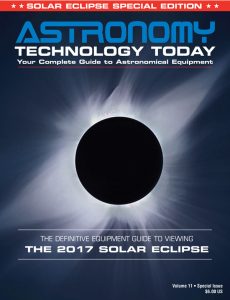 The Astronomy Technology Today editorial staff would like to take this opportunity to remind you of the availability of our Solar eclipse equipment guide – The Definitive Equipment Guide to the 2017 Solar Eclipse. Our goal with the 40 page publication is to provide an easy-to-consume introduction to the technological options for viewing and imaging the Great Solar Eclipse. We cover the gamut of options available including building you own solar viewer, solar glasses, smart phones, DSLR cameras, using astronomy telescopes, solar telescopes, using binoculars, solar filters (including a DYI filter option), CCD astro cameras, astro video cameras, webcams and much more. You can view the guide on our website here – its free and there is no requirement to sign up to read the guide.
The Astronomy Technology Today editorial staff would like to take this opportunity to remind you of the availability of our Solar eclipse equipment guide – The Definitive Equipment Guide to the 2017 Solar Eclipse. Our goal with the 40 page publication is to provide an easy-to-consume introduction to the technological options for viewing and imaging the Great Solar Eclipse. We cover the gamut of options available including building you own solar viewer, solar glasses, smart phones, DSLR cameras, using astronomy telescopes, solar telescopes, using binoculars, solar filters (including a DYI filter option), CCD astro cameras, astro video cameras, webcams and much more. You can view the guide on our website here – its free and there is no requirement to sign up to read the guide.


